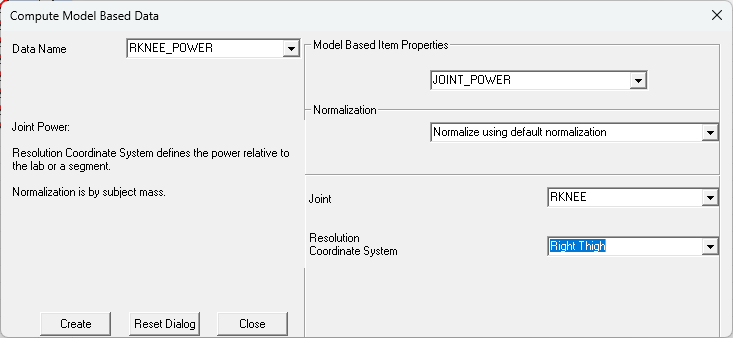Table of Contents
Joint Power
This model-based item represents the joint power for the specified joint resolved into three separate components.
For example, it is possible to express the JOINT POWER of the Right Knee resolved into the Right Thigh's coordinate system and normalized using the individual's mass.
Scalar versus "Vector" and Anatomical Meaning
Properly speaking, Joint Power is a scalar term computed as:
Power = [Mx,My,Mz] . [wx,wy,wz] Power = Mx.wx + My.wy + Mz.wz
It has become common in the biomechanics community, however, to resolve power into a segment coordinate system and this is what this model-based item achieves.
Note: This does not result in Joint Power being a vector! Because of this, there is never a reason to multiply any of the power terms by minus 1. Because power is not a vector there is no need to reflect the signals to between right and left to give them anatomical meaning. In fact, multiplying a term by -1 eliminates the anatomical meaning since a negative power indicates an eccentric contraction.
If you want the scalar item, see JOINT_POWER_SCALAR.
Normalization
There are four options available for normalizing the JOINT_POWER model-based item.
- Normalization Off: The JOINT_POWER item is unnormalized.
- Normalize using default normalization: The default normalization for JOINT_POWER is by participant (subject) mass.
- Normalize to local file metric value: The JOINT_POWER item can be normalized by any metric value in the local C3D file. Another drop down menu will appear to prompt a selection.
- Normalize to global metric value: The JOINT_POWER item can also be normalized by metric values in the GLOBAL workspace. Another drop down menu will appear to prompt a selection.
Necessity of a Joint
In order for Visual3D to calculate Joint Power there must be a Joint created because Joint Angular Velocity is the relative angular velocity between the two segments intersected by the Joint.
It is possible for a joint moment to be non-zero and the joint power to contain No Data. This occurs when there is no “joint” identified by Visual3D, and no joint means no joint angular velocity. For example, a shoulder joint is commonly not identified because the distance from the head of the humerus (origin of the upper arm segment) to the distal end of the torso is greater than the distal radius of the torso.
You can verify this in model builder mode, where you should see a yellow sphere at the proximal end of the humerus segment. You may have to check the box in the display settings to display the joint.
See Also
There is also a model-based item for joint power as a scalar (JOINT_POWER_SCALAR). Or return to LINK_MODEL_BASED items.

